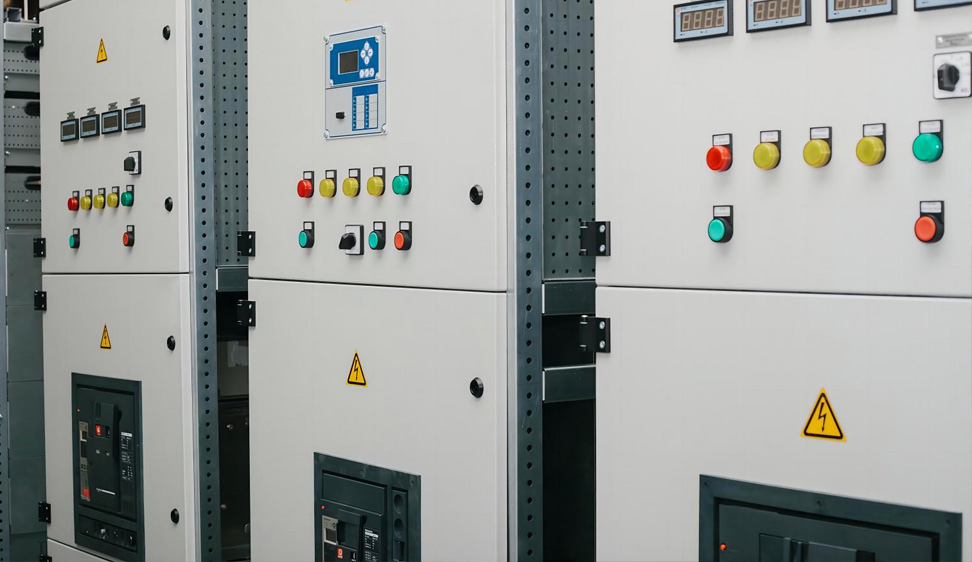What is Medium Voltage Switchgear?
2024-04-15

As the need for higher-voltage systems grows in various industries, medium-voltage switchgear is becoming increasingly popular and drawing more interest from specifiers. Consequently, many individuals are looking to gain a deeper understanding of this product. To provide clarity on MV switchgear, we have put together a comprehensive article discussing its definition, functions, and Types.
1.The difinition for the Medium Voltage Switchgear
What is medium voltage switchgear? According to industry norms, medium switchgear refers to electrical devices operating at voltages ranging from 1 kV to 52 kV. This category covers a significant part of the power distribution range, contributing to the broad scope of medium-voltage switchgear available.
The typical voltage range of electrical systems that utilize this type of switchgear rarely exceeds 52 kV, resulting in a common modification of the medium voltage switchgear definition to encompass switchgear capable of handling voltages up to 36 kV. Be that as it may, the voltage handling capacity of each MV switchgear is tailored to suit the specific system it serves, and thus, its application determines its voltage limit. Now, let's delve into how medium voltage switchgear operation contributes to the seamless functioning of power distribution networks.
2.The Function for the Medium Voltage Switchgear
Like all other types of equipment, the primary purpose of medium-voltage switchgear is to safeguard electrical equipment and circuits. It achieves this by automatically isolating specific components from the power source in case of issues like electrical faults.
These functions include:
* Disconnecting power to ensure the safety of electricians while working on a circuit
* Regulating the amount of power flowing through a system
* Isolating circuits to prevent work on one circuit from impacting others.
3.Components in the Medium Voltage Switchgear
MV switchgear is designed to safeguard electrical systems and equipment by incorporating various switching and safety devices. Depending on the specific application, MV switchgear can be enclosed or open. Let's take a closer look at the primary components that make up medium-voltage switchgear.
Circuit breakers
The switchgear uses a circuit breaker to isolate equipment from the power source. The two primary types of circuit breakers utilized in medium-voltage switchgear are air, oil, and vacuum circuit breakers, which can be either manually or automatically activated.
Fuses
A fuse in switchgear acts as a safety mechanism to prevent overload by incorporating a metal strip that melts when excessive current flows through it. This breaks the electrical path and stops the flow of current to prevent damage.
Switchgear
The switchgear system is equipped with switches designed to regulate the flow of electrical current under normal operating conditions. These switches can handle the specified levels of current and voltage and are also engineered to perform reliably under abnormal conditions, such as short circuits or overloads.
Relays
A switchgear relay is an electrical switch. When an electrical fault occurs, the relay's contacts close, sending a signal to the circuit breaker. This signal triggers the breaker to halt power transmission to the affected circuit or load, making it an essential component in protecting against electrical hazards. Hence, it's commonly referred to as a protective relay.Grounding SwitchesGrounding switches serve to safely discharge accumulated static electricity from equipment by establishing a connection to the ground. These switches are typically operated manually, allowing you to deliberately direct the electric charge away from the equipment and into the ground, effectively neutralizing it. IsolatorsIsolators are devices in switchgear that can connect or disconnect an electrical circuit. They are used to separate a faulty circuit from the operational ones or to isolate a circuit for maintenance reasons.Surge ArrestersSurge arresters are designed to safeguard electrical equipment from, known as voltage spikes potential to cause damage. These devices function by redirecting excess voltage away from the ground.
Transformers for Instrumentation
This category includes current and voltage transformers, which play a crucial role in the safe and efficient operation of switchgear. These transformers can serve as metering and protection devices, allowing switchgear to perform its intended function. Current transformers reduce the current, while voltage transformers, also known as potential transformers, lower the voltage.
Auto Reclosers and Sectionalizes
In medium-voltage switchgear, an auto-recloser can automatically reestablish a power connection or circuit after an electrical fault has been rectified. Conversely, a sectionalizer is designed to isolate a specific part of a circuit, allowing repairs to be carried out without impacting the rest of the circuit.
4.Types of Medium Voltage Switchgear
Different varieties of medium-voltage switchgear exist in the market, characterized by their design and features, such as the type of insulation medium used and the presence of an enclosure. This results in a range of medium-voltage switchgear types available to choose from. Below are some of the most popular options.
Gas Insulated Switchgear (GIS)
Gas-insulated switchgear (GIS) is designed with gas insulation, typically using SF6 or a mix of SF6 and other gases. GIS devices are fully enclosed and utilize gas as the insulating agent. The use of gas insulation enables a reduced gap between breakers, resulting in more compact medium-voltage switchgear that can be installed in constrained spaces.
Air Insulated Switchgear (AIS)
Air Air-insulated switchgear (AIS) utilizes air as the insulating medium, which is why it's sometimes called "air-break" switchgear. Compared to gas-insulated switchgear, AIS is more affordable. However, because air isn't as effective an insulator as gas, the breaker gap needs to be larger. As a result, AIS equipment is typically installed outdoors.
Solid Dielectric Switchgear
Solid Dielectric Switchgear is insulated with solid materials like porcelain or glass, which enhances its durability compared to other medium voltage switchgear types. It is highly resilient to various weather and environmental factors. Nonetheless, the use of solid materials makes it pricier and less adaptable than alternative switchgear options.
Oil Insulated Switchgear
Medium-voltage switchgear that utilizes oil as an insulating medium is known as oil-insulated switchgear. Although oil is an effective insulator and has a lower cost compared to other materials, its flammability and potential environmental harm have led to a decrease in its use in modern times.
Metal Enclosed Switchgear
This medium-voltage switchgear features an external metal enclosure that provides an added layer of mechanical protection, shielding the internal components from exposure. As a result, it offers greater resistance to environmental factors and tampering, making it ideal for industrial and commercial applications.
Metal Clad Switchgear
Metal-clad switchgear shares similarities with metal-enclosed switchgear, but the internal components are encased in separate metal enclosures, providing an additional layer of protection. These enclosures are also grounded and designed to be easily removable, similar to drawers in a cabinet.
Pad Mounted Switchgear
Switchgear installed on pads is a type of metal-clad switchgear that is mounted on a concrete or other solid base, usually placed underground or in outdoor environments. This type of switchgear is commonly used in industrial and commercial settings.
Arc Resistant Switchgear
Arc Resistant SwitchgearArc-resistant switchgear is specifically designed to confine and extinguish an electrical arc flash. It is typically employed in situations where there is a potential for an arc flash, particularly in settings with elevated short-circuit currents. Based on the ANSI/IEEE medium-voltage switchgear standards, this type of switchgear is typically categorized into four types.
Type 1 offers arc resistance only at the front.
Type 2 provides arc resistance across the entire switchgear assembly, including the front, side, and rear.
Type 2B ensures arc resistance on all sides, even with the control compartment doors open.
Type 2C is designed to be arc-resistant both around its perimeter and between compartments.
5.Installation for the Medium Voltage Switchgear
The installation of medium voltage switchgear requires skilled professionals, typically a team of seasoned electricians, to ensure proper and safe operation. Many manufacturers offer specialized training programs to familiarize their personnel with the unique characteristics of medium voltage switchgear, further guaranteeing accurate installation and minimizing potential risks.
To begin installing MV switchgear, the initial task is to identify the voltage and current of the power source. This data is crucial for choosing the correct switchgear rating for the specific use. After selecting the MV switchgear, it is essential for the electricians to adhere to these guidelines throughout the installation.
It is important to ensure that the installation location is flat and has good ventilation. Verify that all drawings and technical details are accurate. Make sure all necessary materials for installing the MV switchgear are on hand. Qualified professionals should handle all electrical connections. Once the MV switchgear installation is done, testing will be required using different methods and tools. The test results must meet the manufacturer's specified criteria as per the specific medium voltage switchgear requirements.
6. Maintenance for the Medium Voltage Switchgear
Medium-voltage (MV) switchgear necessitates regular upkeep to ensure optimal performance. As part of this maintenance, the various components are inspected for any indications of deterioration or harm. The frequency of these inspections will depend on the specific type of MV switchgear and its intended use.
Maintaining Medium Voltage Switchgear: A Preventive Approach.
◆ Examining parts for rust or grime,
◆ Verifying the proper functioning of the switchgear's interlock mechanisms,
◆ Looking for indications of overheating,
◆ Conducting tests on different components,
◆ Evaluating the resistance of the switchgear insulation and possibly replacing it due to wear or harm are all important tasks in maintaining medium-voltage switchgear systems.
Manufacturers typically offer guidance on the upkeep of their products, but it is common for electricians in charge of medium-voltage installations to maintain a checklist for maintenance purposes.
Summary
Most power systems nowadays rely heavily on medium-voltage switchgear to regulate power distribution and safeguard electrical equipment and systems. Various types of MV switchgear are available, and it's crucial to follow the manufacturer's instructions when installing or replacing them to ensure proper functioning.





